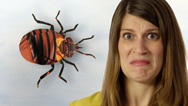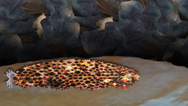The Poop Cure
- By Anna Rothschild
- Posted 04.16.15
- NOVA
Fecal transplants—putting one person’s poop into another’s gut—are surprisingly effective cures for the dangerous bacterial infection, Clostridium difficile. However, they challenge our ideas of what it means to be “clean” and “dirty.” Learn more in this episode of Gross Science.
Transcript
The Poop Cure
Posted: April 15, 2015
Anna Rothschild: Ever wanted someone else’s poo pumped through a tube in your nose? Me neither. But doctors are performing this procedure on patients across the country.
I’m Anna Rothschild, and this is Gross Science.
Inside every person’s digestive tract there are trillions of bacteria and other microbes, and these little guys are really important. They do things like produce molecules your colon cells need to survive, or they extract nutrients from your food. Scientists call these microbial communities your “gut microbiome.” And in a healthy person’s gut, there’s a balance among the organisms present that keeps the whole system in check.
But, let’s say you wipe out a population of bacteria, say because you had to take antibiotics for some reason. Other microbes can suddenly proliferate out of control, in ways they never could before. This is exactly what happens in many patients who have Clostridium difficile, or C. diff, infections. Certain microbes disappear, allowing the bacterium C. diff to take over, causing diarrhea and even deadly inflammation of the colon.
So, how do doctors reset the microbial balance? Well, recently they’ve been turning to something called a “fecal transplant,” which while extremely effective, is also about as gross as it sounds.
Essentially, doctors collect poop from a healthy donor, mix it up with saline, and then filter out any undigested bits to create a brown milkshake looking substance.
They administer the poop slurry in one of three ways. The first is backwards, through the anus. The second is through the nose, using a tube that gets threaded down to the person’s stomach or small intestines. And a newer experimental way is giving the treatment in pill form.
The idea here is that the poop slurry contains a complement of gut microbes from the healthy donor, which re-colonize the patient’s gut and out-compete the disease-causing bacteria.
This process sounds totally revolting, but recent studies have shown that patients with C. diff who were given fecal transplants had an average cure rate between 91 and 93%.
Fecal transplants really challenge our ideas of what we think of as “clean” and “dirty.” Current research is showing that they’re simple life saving treatments, and yet, I wouldn’t blame anyone for being a little squeamish.
By the way, don’t try this at home. Ew.
Joe Hanson: That was definitely gross. Wanna know more about C. diff and other superbugs? Head on over and watch my video at It’s Okay To Be Smart.
Credits
PRODUCTION CREDITS:
- Host, Writer, Animator, Editor
- Anna Rothschild
- DP, Sound, Researcher, Intern Extraordinaire
- Elizabeth Gillis
- Music: Big Poppa
- © Podington Bear
IMAGES
- ClostridiumDifficile
- Wikimedia Commons/CDC
SFX
(used with permission from author)
IMAGE
- (main image: poop in beaker)
- © WGBH Educational Foundation
Sources
Want more info?
More on fecal transplants, the first poop bank, and what the FDA has to say:
http://commonhealth.wbur.org/2014/03/first-stool-bank-survive
Curious about donating feces? OpenBiome:
http://www.openbiome.org/
Interview on the history of fecal transplants, recent studies, and where the field is headed:
http://www.ncbi.nlm.nih.gov/pmc/articles/PMC3365524/
Related Links
-

Gross Science
Bizarre stories from the slimy, smelly, creepy world of science.
-

What Does Disease Smell Like?
Sometimes doctors can diagnose you based on how you smell.
-

The Three-Foot-Long Footworm
Guinea worms have plagued humans for millennia, but they’re almost extinct.
-

Sea Cucumber Evisceration
Sea cucumbers can expel their internal organs and then regrow them.

